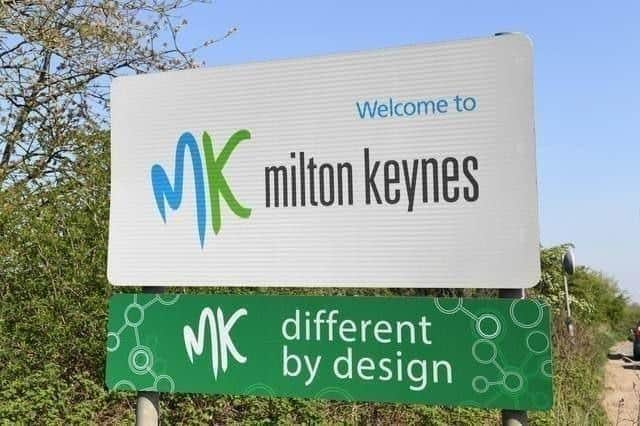Here are 7 wacky things you may now know about Milton Keynes
This article contains affiliate links. We may earn a small commission on items purchased through this article, but that does not affect our editorial judgement.
and live on Freeview channel 276
MK’s expert historian John Taylor has today revealed seven astonishing things that happened – or almost happened – in our city over the decades.
John, who wrote the much-loved The Way We Were column for the MK Citizen for many years, is currently working on his third book about the history of Milton Keynes.
Here are some of his favourite tales:
Advertisement
Hide AdAdvertisement
Hide Ad

- A flourishing passion flower bush was planted outside the city cente, near the doors of the old Torenzo’s restaurant in the early 1980s. It soon became very popular – for the wrong reasons. People discovered that not only did it look stunning, but the leaves could have mind-blowing effects if they were smoked like tobacco. Drug users claimed it gave them “a short lasting marijuana type high”. Milton Keynes Development Corporation gardeners moved swiftly in to prune the bush back to a few stalks, while a red-faced MKDC spokesman said: “It needed pruning. We didn’t cut it back to stop it being used as a drug. I didn’t even know it could be.”
- In June 1980 a sculpture called Octo costing £12,000 was officially unveiled at the city centre, commissioned by the Norwich Union Insurance Group Designed by London artist Wendy Taylor, a London based artist, it was six feet high and stood in a pool of water. But despite now being known as the ‘figure of eight’ sculpture. it was NOT meant to be a figure of eight. An MKDC spokesman said at the time: “It is not a figure of eight but is based on the mobius strip mathematical symbol – a one sided surface formed by joining together the two ends of a long rectangular strip, one end being twisted through 180 degrees before the join is made”. Well, who knew?
- On November 15th 1989, 31-year-old Wendy Moore from Downhead Park became the first person to have a water birth at Milton Keynes hospital. The hospital authorities had cold-shouldered the idea when she first approached them, mainly from concerns that water could seep through the floor into the X Ray department below. Wendy then wrote to MP Bill Benyon, who wrote to the hospital. Wendy said; “About a week later the people from the hospital came round to see me and from then on it was plain sailing.” For the occasion she was supplying the hospital with a specially-made birth bath from the Active Birth Centre in London. Her son Calvin Keith was born successfully and set the trend for water birth become common practice at the hospital.
- In May 1986 Dickins and Jones at CMK became famous for installing a high tech point of sale systems linked to a computer. The contract was awarded to NCR Computers and Terminals to supply and fit of over 220 terminals. “Magnetic stripe readers attached to the terminals will be used for all credit card transactions, including the store’s own Frasercard,” reported the local press in utter awe.
- In June 1986 it was announced that MK would be setting a trend towards a cashless society with a high tech trial of up to 30 terminals installed at shops, stores and filling stations in the city. Midland Bank customers will be able to shop there without cash, cheque books or credit cards, but other bank users would be excluded. “Customers will have a card with their own special number which will automatically transfer money from their account to the shop,” stated the Citizen. The Milton Keynes experiment was one of just three nationally towards the cashless society.
- Milton Keynes almost had a concrete jungle complete with concrete palm trees and concrete monkeys as its main tourist attraction. In September 1988 Milton Keynes Council came up with ways to put MK more on the map. Councillors let their imagination run riot with ideas, all of which they vowed to investigate. These included the concrete jungle, following the success of the now famous concrete cows, and a huge water world park under a glass dome. Other ideas were horse drawn carriage tours around the estates and parks and a model town representing a miniature Milton Keynes. None of the ideas came into fruition.
- A historic pub had an unlikely claim to fame in the 1980s. The landlord of the Bull and Butcher was a well known local character as also was his son, Gordon McKenzie. Gordon demonstrated his impressive fire eating talents by stripping the paintwork from a car, saying: “Why use a blowlamp when I can blow a stronger flame myself?” He also developed a reputation for munching on razor blades, having first cut his teeth on crunching glass! Inevitably such unique skills led a career in entertainment during which, billed as Gordon ‘Mental' McKenzie, he even performed abroad. His co-stars were his two pet rats Sheila and Bruce, whose early training had been undertaken in the pub shed.
You can read more of John’s historic musings in his books called The Birth of Milton Keynes, which are available here on Amazon or at Blackwells and Waterstones.
The first volume describes the political wrangling up to the announcement that the new city was going to be built. The second tells us about the creation of the Milton Keynes Development Corporation and the development of the master plan, which is essentially the basis for Milton Keynes as we know it today.
The third volume is still in preparation and will describe the implementation of this plan up to the handover by MKDC to local authorities.